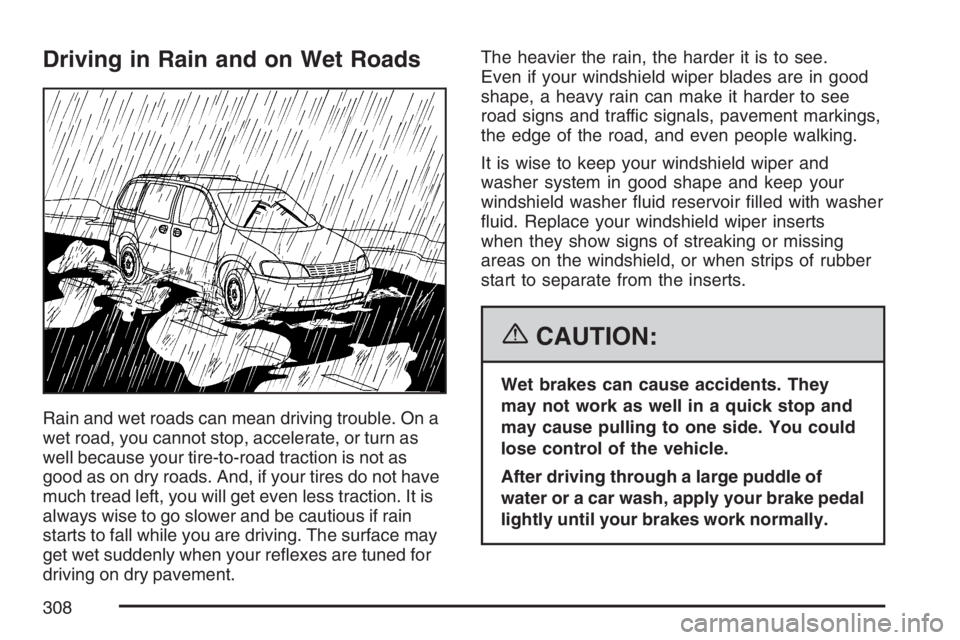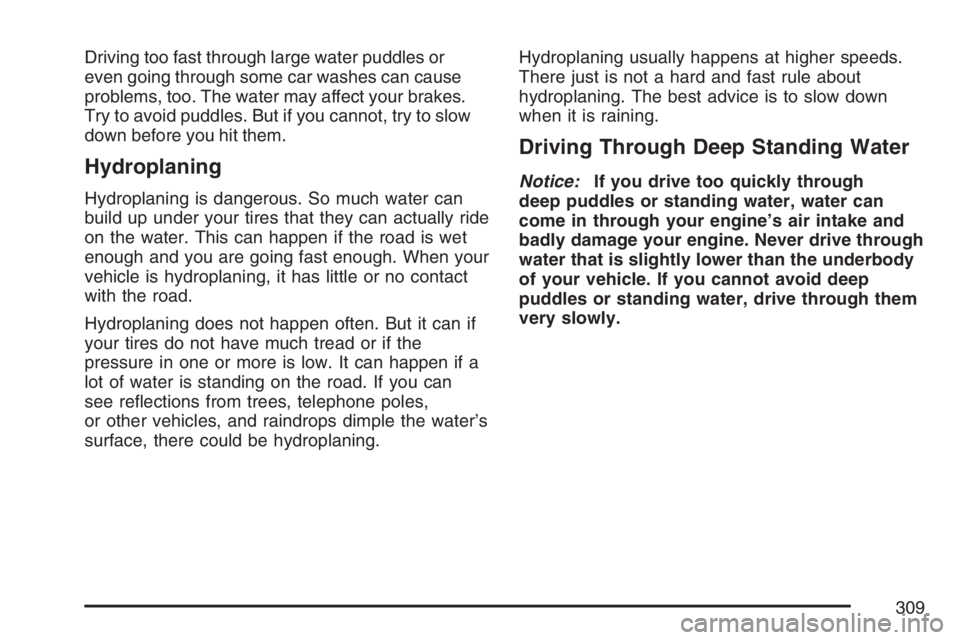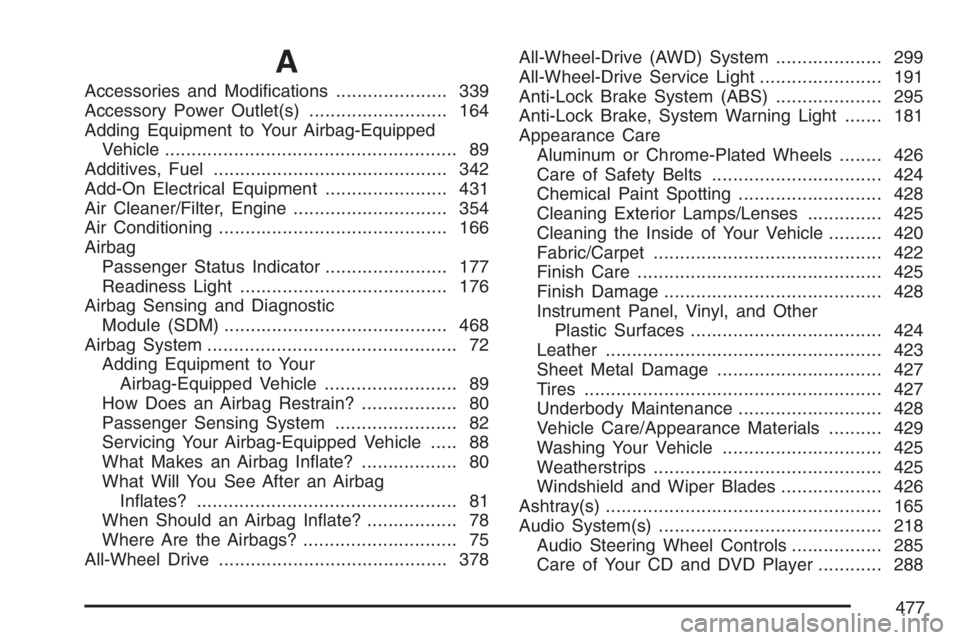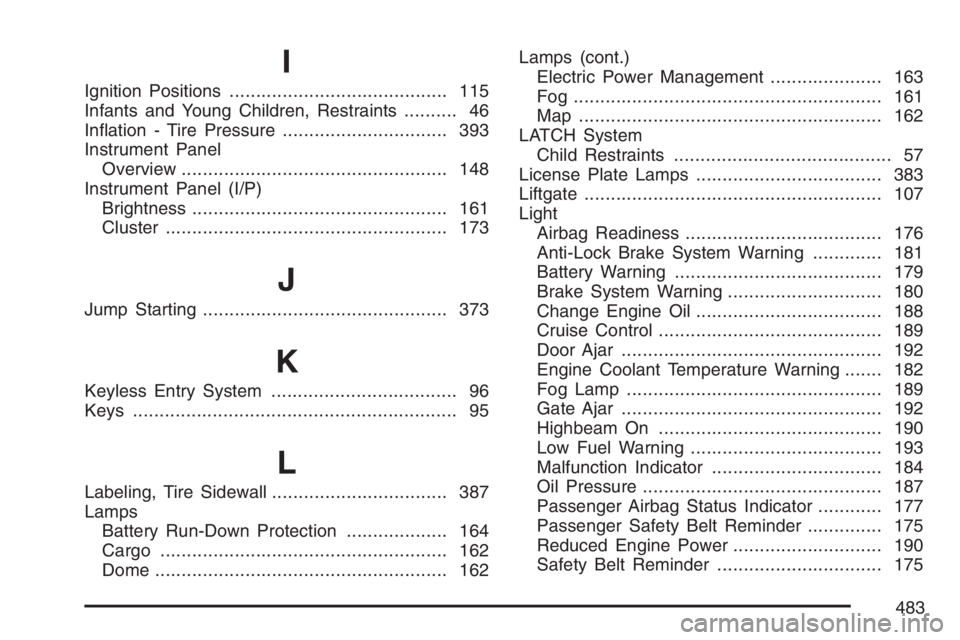2007 PONTIAC TORRENT brake light
[x] Cancel search: brake lightPage 308 of 490

Driving in Rain and on Wet Roads
Rain and wet roads can mean driving trouble. On a
wet road, you cannot stop, accelerate, or turn as
well because your tire-to-road traction is not as
good as on dry roads. And, if your tires do not have
much tread left, you will get even less traction. It is
always wise to go slower and be cautious if rain
starts to fall while you are driving. The surface may
get wet suddenly when your re�exes are tuned for
driving on dry pavement.The heavier the rain, the harder it is to see.
Even if your windshield wiper blades are in good
shape, a heavy rain can make it harder to see
road signs and traffic signals, pavement markings,
the edge of the road, and even people walking.
It is wise to keep your windshield wiper and
washer system in good shape and keep your
windshield washer �uid reservoir �lled with washer
�uid. Replace your windshield wiper inserts
when they show signs of streaking or missing
areas on the windshield, or when strips of rubber
start to separate from the inserts.
{CAUTION:
Wet brakes can cause accidents. They
may not work as well in a quick stop and
may cause pulling to one side. You could
lose control of the vehicle.
After driving through a large puddle of
water or a car wash, apply your brake pedal
lightly until your brakes work normally.
308
Page 309 of 490

Driving too fast through large water puddles or
even going through some car washes can cause
problems, too. The water may affect your brakes.
Try to avoid puddles. But if you cannot, try to slow
down before you hit them.
Hydroplaning
Hydroplaning is dangerous. So much water can
build up under your tires that they can actually ride
on the water. This can happen if the road is wet
enough and you are going fast enough. When your
vehicle is hydroplaning, it has little or no contact
with the road.
Hydroplaning does not happen often. But it can if
your tires do not have much tread or if the
pressure in one or more is low. It can happen if a
lot of water is standing on the road. If you can
see re�ections from trees, telephone poles,
or other vehicles, and raindrops dimple the water’s
surface, there could be hydroplaning.Hydroplaning usually happens at higher speeds.
There just is not a hard and fast rule about
hydroplaning. The best advice is to slow down
when it is raining.
Driving Through Deep Standing Water
Notice:If you drive too quickly through
deep puddles or standing water, water can
come in through your engine’s air intake and
badly damage your engine. Never drive through
water that is slightly lower than the underbody
of your vehicle. If you cannot avoid deep
puddles or standing water, drive through them
very slowly.
309
Page 369 of 490

Brakes
Brake Fluid
Your brake master
cylinder reservoir is
�lled with DOT-3 brake
�uid. SeeEngine
Compartment Overview
on page 348for the
location of the reservoir.
There are only two reasons why the brake �uid
level in the reservoir might go down. The �rst
is that the brake �uid goes down to an acceptable
level during normal brake lining wear. When
new linings are put in, the �uid level goes back
up. The other reason is that �uid is leaking out of
the brake system. If it is, you should have your
brake system �xed, since a leak means that
sooner or later your brakes will not work well, or
will not work at all.So, it is not a good idea to top off your brake �uid.
Adding brake �uid will not correct a leak. If you
add �uid when your linings are worn, then you will
have too much �uid when you get new brake
linings. You should add or remove brake �uid, as
necessary, only when work is done on the
brake hydraulic system.
{CAUTION:
If your vehicle has too much brake �uid, it
can spill on the engine. The �uid will burn
if the engine is hot enough. You or others
could be burned, and your vehicle could
be damaged. Add brake �uid only when
work is done on the brake hydraulic
system.
When your brake �uid falls to a low level, your
brake warning light will come on. SeeBrake
System Warning Light on page 180.
369
Page 371 of 490

{CAUTION:
The brake wear warning sound means that
soon the brakes will not work well. That
could lead to an accident. When you hear
the brake wear warning sound, have your
vehicle serviced.
Notice:Continuing to drive with worn-out
brake pads could result in costly brake repair.
Some driving conditions or climates may cause
a brake squeal when the brakes are �rst applied or
lightly applied. This does not mean something is
wrong with your brakes.
Properly torqued wheel nuts are necessary to help
prevent brake pulsation. When tires are rotated,
inspect brake pads for wear and evenly tighten
wheel nuts in the proper sequence to GM torque
speci�cations.
Brake linings should always be replaced as
complete axle sets.
Brake Pedal Travel
See your dealer if the brake pedal does not return
to normal height, or if there is a rapid increase in
pedal travel. This could be a sign of brake trouble.
Brake Adjustment
Every time you apply the brakes, with or without
the vehicle moving, your brakes adjust for wear.
Replacing Brake System Parts
The braking system on a vehicle is complex. Its
many parts have to be of top quality and work well
together if the vehicle is to have really good
braking. Your vehicle was designed and tested with
top-quality GM brake parts. When you replace parts
of your braking system — for example, when your
brake linings wear down and you need new ones
put in — be sure you get new approved GM
replacement parts. If you do not, your brakes may
no longer work properly. For example, if someone
puts in brake linings that are wrong for your vehicle,
the balance between your front and rear brakes can
change — for the worse. The braking performance
you have come to expect can change in many other
ways if someone puts in the wrong replacement
brake parts.
371
Page 444 of 490

Maintenance Footnotes
(a)Visually inspect brake lines and hoses for
proper hook-up, binding, leaks, cracks, cha�ng,
etc. Inspect disc brake pads for wear and rotors for
surface condition. Inspect other brake parts,
including calipers, parking brake, etc. Check
parking brake adjustment.
(b)Visually inspect front and rear suspension and
steering system for damaged, loose, or missing
parts, signs of wear. Visually check constant
velocity joints, rubber boots, and axle seals for
leaks.
(c)Visually inspect hoses and have them replaced
if they are cracked, swollen, or deteriorated.
Inspect all pipes, �ttings and clamps; replace with
genuine GM parts as needed. To help ensure
proper operation, a pressure test of the cooling
system and pressure cap and cleaning the outside
of the radiator and air conditioning condenser is
recommended at least once a year.
(d)Visually inspect wiper blades for wear or
cracking. Replace wiper blades that appear worn
or damaged or that streak or miss areas of
the windshield.(e)Make sure the safety belt reminder light and all
your belts, buckles, latch plates, retractors, and
anchorages are working properly. Look for
any other loose or damaged safety belt system
parts. If you see anything that might keep a safety
belt system from doing its job, have it repaired.
Have any torn or frayed safety belts replaced. Also
look for any opened or broken airbag coverings,
and have them repaired or replaced. The
airbag system does not need regular maintenance.
(f)Lubricate all key lock cylinders, hood latch
assemblies, secondary latches, pivots, spring
anchor and release pawl, hood and door hinges,
rear folding seats, and liftgate hinges. More
frequent lubrication may be required when
exposed to a corrosive environment. Applying
silicone grease on weatherstrips with a clean cloth
will make them last longer, seal better, and not
stick or squeak.
(g)If you drive regularly under dusty conditions,
the �lter may require replacement more often.
444
Page 477 of 490

A
Accessories and Modi�cations..................... 339
Accessory Power Outlet(s).......................... 164
Adding Equipment to Your Airbag-Equipped
Vehicle....................................................... 89
Additives, Fuel............................................ 342
Add-On Electrical Equipment....................... 431
Air Cleaner/Filter, Engine............................. 354
Air Conditioning........................................... 166
Airbag
Passenger Status Indicator....................... 177
Readiness Light....................................... 176
Airbag Sensing and Diagnostic
Module (SDM).......................................... 468
Airbag System............................................... 72
Adding Equipment to Your
Airbag-Equipped Vehicle......................... 89
How Does an Airbag Restrain?.................. 80
Passenger Sensing System....................... 82
Servicing Your Airbag-Equipped Vehicle..... 88
What Makes an Airbag In�ate?.................. 80
What Will You See After an Airbag
In�ates?................................................. 81
When Should an Airbag In�ate?................. 78
Where Are the Airbags?............................. 75
All-Wheel Drive........................................... 378All-Wheel-Drive (AWD) System.................... 299
All-Wheel-Drive Service Light....................... 191
Anti-Lock Brake System (ABS).................... 295
Anti-Lock Brake, System Warning Light....... 181
Appearance Care
Aluminum or Chrome-Plated Wheels........ 426
Care of Safety Belts................................ 424
Chemical Paint Spotting........................... 428
Cleaning Exterior Lamps/Lenses.............. 425
Cleaning the Inside of Your Vehicle.......... 420
Fabric/Carpet........................................... 422
Finish Care.............................................. 425
Finish Damage......................................... 428
Instrument Panel, Vinyl, and Other
Plastic Surfaces.................................... 424
Leather.................................................... 423
Sheet Metal Damage............................... 427
Tires........................................................ 427
Underbody Maintenance........................... 428
Vehicle Care/Appearance Materials.......... 429
Washing Your Vehicle .............................. 425
Weatherstrips........................................... 425
Windshield and Wiper Blades................... 426
Ashtray(s).................................................... 165
Audio System(s).......................................... 218
Audio Steering Wheel Controls................. 285
Care of Your CD and DVD Player............ 288
477
Page 478 of 490

Audio System(s) (cont.)
Care of Your CDs and DVDs................... 288
Navigation/Radio System, see
Navigation Manual................................ 274
Radio with CD................................222, 228
Radio with CD and DVD.......................... 239
Setting the Time...................................... 220
Theft-Deterrent Feature............................ 285
Understanding Radio Reception............... 287
Automatic Headlamp System....................... 160
Automatic Transaxle
Fluid........................................................ 357
Operation................................................. 119
B
Battery........................................................ 372
Electric Power Management..................... 163
Run-Down Protection............................... 164
Battery Warning Light.................................. 179
Before Leaving on a Long Trip.................... 313
Brake
Anti-Lock Brake System (ABS)................. 295
Emergencies............................................ 297
Parking.................................................... 122
System Warning Light.............................. 180
Brakes........................................................ 369Braking....................................................... 294
Braking in Emergencies............................... 297
Break-In, New Vehicle................................. 114
Bulb Replacement....................................... 380
Halogen Bulbs......................................... 380
Headlamps, Front Turn Signal,
Sidemarker, and Parking Lamps........... 381
License Plate Lamps................................ 383
Replacement Bulbs.................................. 384
Taillamps, Turn Signal, Stoplamps
and Back-up Lamps.............................. 382
Buying New Tires........................................ 401
C
Calibration..........................................129, 131
California Fuel............................................. 342
California Proposition 65 Warning................ 340
Canadian Owners........................................... 3
Capacities and Speci�cations...................... 436
Carbon Monoxide..............107, 127, 316, 328
Care of
Safety Belts............................................. 424
Your CD and DVD Player........................ 288
Your CDs and DVDs................................ 288
Cargo Lamp................................................ 162
CD, MP3 ............................................257, 264
478
Page 483 of 490

I
Ignition Positions......................................... 115
Infants and Young Children, Restraints.......... 46
In�ation - Tire Pressure............................... 393
Instrument Panel
Overview.................................................. 148
Instrument Panel (I/P)
Brightness................................................ 161
Cluster..................................................... 173
J
Jump Starting.............................................. 373
K
Keyless Entry System................................... 96
Keys............................................................. 95
L
Labeling, Tire Sidewall................................. 387
Lamps
Battery Run-Down Protection................... 164
Cargo...................................................... 162
Dome....................................................... 162Lamps (cont.)
Electric Power Management..................... 163
Fog .......................................................... 161
Map ......................................................... 162
LATCH System
Child Restraints......................................... 57
License Plate Lamps................................... 383
Liftgate........................................................ 107
Light
Airbag Readiness..................................... 176
Anti-Lock Brake System Warning............. 181
Battery Warning....................................... 179
Brake System Warning............................. 180
Change Engine Oil................................... 188
Cruise Control.......................................... 189
Door Ajar................................................. 192
Engine Coolant Temperature Warning....... 182
Fog Lamp................................................ 189
Gate Ajar................................................. 192
Highbeam On.......................................... 190
Low Fuel Warning.................................... 193
Malfunction Indicator................................ 184
Oil Pressure............................................. 187
Passenger Airbag Status Indicator............ 177
Passenger Safety Belt Reminder.............. 175
Reduced Engine Power............................ 190
Safety Belt Reminder............................... 175
483